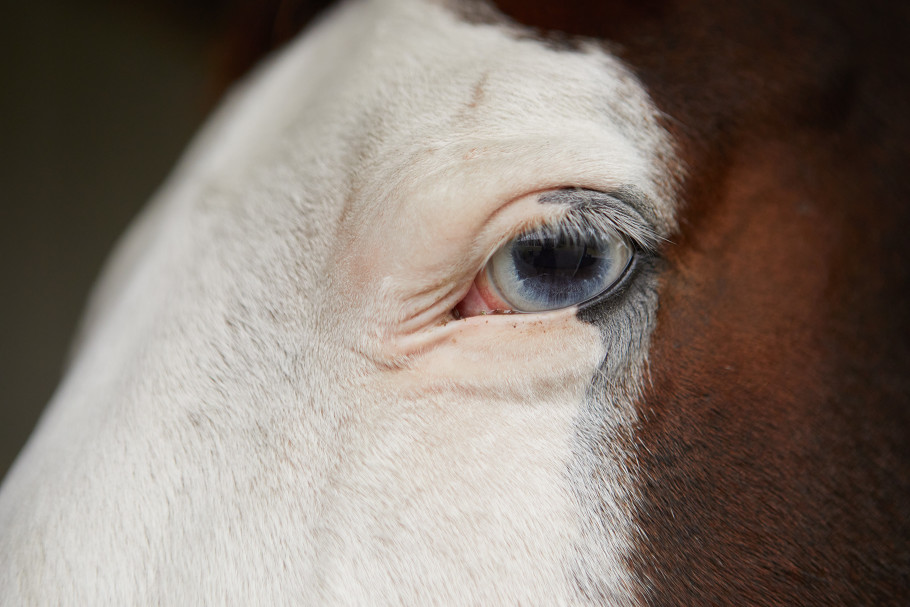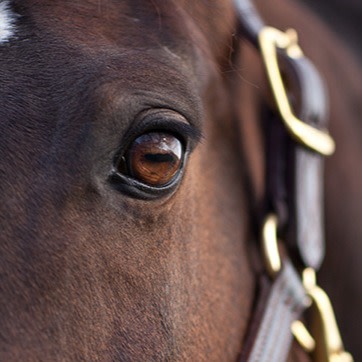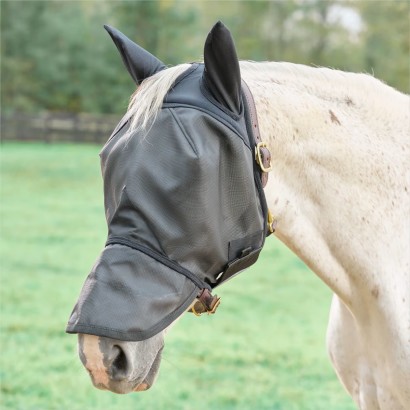Moon Blindness in Horses - Equine Recurrent Uveitis (ERU)
Shining a light on one of the most common eye issues in horses.
Updated April 30, 2024 | Reviewed By: Jamie Whittenburg, DVM

Some horses seem to be prone to eye problems, from injury and trauma to diseases and conditions. One specific issue occurs when the uvea, the middle layer of the eye, becomes inflamed. This inflammation is referred to as uveitis.
Like most medical conditions, uveitis can be acute (a single, short-term incidence) or chronic (persistent, long-term). When a horse suffers from repeated, intermittent episodes of uveitis over a long period (in one or both eyes) they may develop moon blindness, formally called Equine Recurrent Uveitis (ERU).
Moon blindness in horses is an immune-mediated condition, meaning the body attacks its own tissues, and may be inherited. It is the most common cause of blindness in horses.
Causes of Moon Blindness in Horses
Even though 2-25% of horses globally have ERU [1], the exact cause is not yet known. It is thought to be a complex autoimmune disease influenced by both genetics and environmental factors.
Though all horses are at some risk of developing uveitis, moon blindness is more likely to occur in Appaloosas. Research has found that Appaloosa horses are 8 times more likely to develop uveitis and about 4 times more likely to become blind as a result of ERU [2]. Leopard Appaloosas seem more at risk than those with blankets or dark-colored patterns. Other specific breeds like American Quarter Horses, Paints, and Warmbloods are also known to be more affected by ERU.
Infection caused by the spiral bacteria (spirochete) Leptospira spp. has been associated with moon blindness and is more commonly reported in warm, tropical environments.
Not all horses that develop a single episode of uveitis will develop moon blindness, but each episode does put them at risk for the condition.
Why is it Called Moon Blindness?
The term “moon blindness” originated in the 1600s. People thought that the recurring attacks were related to phases of the moon, which we now know is incorrect.
ERU is also synonymous with the medical term periodic ophthalmia.
Signs of ERU

ERU can occur in one or both eyes and may affect each differently. Clinical signs are not unique to this condition but merely indicate that a horse is experiencing eye inflammation and include:
- Squinting and sensitivity to light
- Tearing
- The white of the eye (and surrounding membranes) becoming bloodshot, known as “red eye”
- A cloudy appearance or bluish haze to the eye
- Swelling of the eyelids
A horse displaying any of these signs should be seen immediately by a veterinarian. Early diagnosis and treatment may prevent the condition from worsening, causing blindness, or even loss of the eye in severe cases.
Diagnosing Equine Eye Conditions
History and Signalment
As with any physical examination, evaluating a horse’s eyes begins with taking a history and signalment from the owner. In the medical field, “history” means the facts leading up to the patient’s current situation and includes:
- When the problem started and how long it’s been going on
- What signs and symptoms were observed
- If any treatment has been given
- If this is the first time the horse has experienced this problem
- What other problems the horse is currently having or recently had (illness or injury)
- What medications and supplements the horse is receiving
- The horse’s vaccination and deworming status
“Signalment” means the horse’s age, breed, and sex (and reproductive status), and sometimes includes defining characteristics like color, markings, height, and weight.
How might a vet use history and signalment to help them diagnose a case of uveitis or a more specific diagnosis of ERU? Well, knowing that a horse is an Appaloosa (a breed predisposed to ERU) and that this horse was recently infected with leptospirosis (a known trigger for ERU) gives clues that put the condition higher up on the list of possibilities. This is especially true if this is not the horse’s first episode of eye pain and inflammation.
Examining Your Horse’s Eyes

The ophthalmological exam of a horse involves looking at structures on the:
- Outside of the eye (such as the eyelids and cornea)
- Inside of the eye (pupil, lens, etc.)
- Back of the eye (like the retina)
Your vet will use a variety of tools and tests to evaluate the health and integrity of these different structures of the eye. These include:
- Staining the cornea to check for scratches or ulcers
- Measuring the pressure inside the eye (similar to the glaucoma test human eye doctors perform)
- Evaluating the pupil’s response to bright light
A combination of your horse’s history and the physical exam will hopefully lead to a diagnosis and treatment plan.
Treatment of Moon Blindness in Horses
The goals of treating ERU are to:
- Control pain and inflammation
- Slow its progression and prevent vision loss
- Treat the underlying cause or trigger factor
To make horses more comfortable and limit inflammation inside the eye, vets often prescribe non-steroidal anti-inflammatory drugs (NSAID) like Banamine systemically (body-wide with an injection) along with steroids topically (applied directly to the eye itself).
Atropine is another medication that is often prescribed when dealing with the early stages of uveitis or an ERU flare-up. Since atropine dilates the eye, vets usually recommend that horses stay inside while this drug is in their system or wear a fly mask outside to reduce sunlight.
Vets remind horse owners not to treat eyes without a diagnosis, even if uveitis is the likely culprit. The medications used to treat it will aggravate other conditions, like corneal ulcers. For that same reason, owners are urged to contact their vet immediately for a recheck if the eye’s appearance worsens during ERU treatment. Not properly treating ERU can lead to cataracts, glaucoma, and blindness.
Preventing Future Episodes of Equine Recurrent Uveitis
ERU often increases in severity with each episode. It is common practice to try to prevent future episodes by keeping affected horses on a low-dose, daily regimen of anti-inflammatories their veterinarian recommends.
Another technique (suprachoroidal cyclosporine implant) has been shown to both decrease the recurrence of uveitis as well as limit the severity and length of episodes. By surgically implanting a disk that provides a sustained release of the immunosuppressive drug cyclosporine, horses experience three to four years of reduced signs, which may slow the progression of the disease.
Surgical removal of the affected eye (enucleation) is another option for those horses who continue to suffer flare-ups and whose pain cannot be controlled.
Long-term Management of Horses with Uveitis

Along with aggressive treatment during episodes of acute uveitis, experts recommend following these practices for horses diagnosed with ERU, some of which are good general horse care advice, and others are specific to this eye condition:
- Provide proper health and wellness care including vaccines, parasite control, dental work and a high-quality diet.
- Prevent eye trauma by choosing appropriate turnout buddies and ensuring stalls, paddocks, and pastures are safe.
- Reduce environmental triggers such as sun, wind, bugs, and dust with fly masks, screens, and appropriate bedding.
- Ensure your horse is up to date on their vaccinations, especially against leptospirosis.
Supplements That May Support Ocular Health
Speak with your veterinarian about giving a supplement formulated to support eye health and promote a normal immune response. Certain ingredients that can support eye health include:
- Antioxidants such as lutein, astaxanthin, and zeaxanthin work within retina cells to help protect against oxidative damage from UV rays.
- Flavonoids like quercetin and luteolin provide antioxidant effects and may help protect against allergic reactions.
- Vitamin A is critical for vision and supports the function of the protective outer layer of the eye (cornea).
- Vitamin C plays a role in protecting against damage from UV light and free radicals.
- Properties in omega 3 fatty acids may help promote a normal response to inflammation in the body and aid in the absorption of fat-soluble vitamins.
When caring for a horse with moon blindness, it’s important to be extremely vigilant in looking for subtle signs of an episode. This is necessary so your horse receives the proper treatment as soon as possible to help prevent eye damage.
Ask the Vet Video on Moon Blindness
Watch as Dr. Lydia Gray describes moon blindness, how inflammation affects the eye, and tips for prevention.
Evidence-Based References
- Gilger B.C., Hollingsworth S.R. Diseases of the uvea, uveitis, and recurrent uveitis. In: Gilger B.C., editor. Equine Ophthalmology. 3rd ed. Wiley Blackwell; Ames, IA, USA: 2017. pp. 369–415.
- Rockwell H, Mack M, Famula T, et al. Genetic investigation of equine recurrent uveitis in Appaloosa horses. Anim Genet. 2020;51(1):111-116. doi:10.1111/age.12883